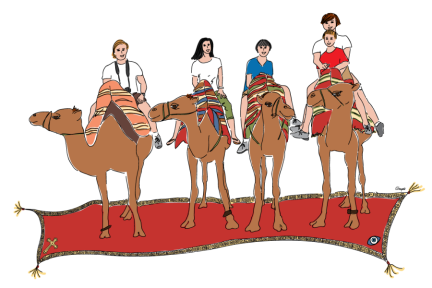The highlight for me, in all of Spain, was seeing the Alhambra.  Having read a book about Catherine of Aragon, (The Constant Princess) before seeing her childhood home, the Alhambra, prepared me in a wonderful way! Reading about the descriptiveness of her childhood Moorish home during its finest regalia gave me such a sense of what to appreciate once I arrived there. I recalled the details of the first few chapters of the book when the character of Catherine describes the details of this palace and all of its servants and royalty. You must see the Alhambra in Granada and then drive over to Ronda, Spain. Try not to go when it’s hot because you’ll be tempted to rush through it.
Having read a book about Catherine of Aragon, (The Constant Princess) before seeing her childhood home, the Alhambra, prepared me in a wonderful way! Reading about the descriptiveness of her childhood Moorish home during its finest regalia gave me such a sense of what to appreciate once I arrived there. I recalled the details of the first few chapters of the book when the character of Catherine describes the details of this palace and all of its servants and royalty. You must see the Alhambra in Granada and then drive over to Ronda, Spain. Try not to go when it’s hot because you’ll be tempted to rush through it.


 Something that particularly moved me was that the Alhambra has a connection to me as an American. This is where King Ferdinand and Queen Isabella commissioned Christopher Columbus to sail to the New World which led us to the discovery of the Americas. To stand in the room where they all were when this historic moment happened was intense for me. We also found out that Washington Irving had an apartment here. The jalis and calligraphy on this palace was unlike anything we had ever seen. My 9 year old son even remarked on it. My architect friend back home pointed out these stylistic treasures to me. Arabic script and white cursive or kufic characters of verses and poems are inscribed onto the backgrounds.
Something that particularly moved me was that the Alhambra has a connection to me as an American. This is where King Ferdinand and Queen Isabella commissioned Christopher Columbus to sail to the New World which led us to the discovery of the Americas. To stand in the room where they all were when this historic moment happened was intense for me. We also found out that Washington Irving had an apartment here. The jalis and calligraphy on this palace was unlike anything we had ever seen. My 9 year old son even remarked on it. My architect friend back home pointed out these stylistic treasures to me. Arabic script and white cursive or kufic characters of verses and poems are inscribed onto the backgrounds.
Three vocabulary words that describe the Alhambra are:
- alcazaba which means fortress
- alcazar which means palace
- medina which means city
Another interesting fact about the Alhambra is that it actually takes on three different color tones depending on the light of day reflecting the iron hue of the towers and walls surrounding the hill. It is red but becomes silver at starlight and transforms into gold by sunlight. The words alqala hamra’ means red.
This Moorish palace became a Christian court in 1492 under the Catholic monarchs, Ferdinand and Isabella. During the 18th century and part of the 19th century, the Alhambra was neglected and many sections were converted into dungheaps and taverns where thieves and beggars resided. Napoleon’s troops used the palace as barracks. Some of the towers were blown apart by the French during the War of Independence. But in 1870, protection and restoration turned the Alhambra into national monument, thankfully.
suggested reading: The Alhambra told to Children by Ediciones Miguel Sanchez.
The Constant Princess by Philippa Gregory
suggested series: Isabel
(pictured below is my son at the palace door)






 photos by Gina and Patrick
photos by Gina and Patrick
take this quiz: www.gypsyfamilytravel.com/alhambra-lesson/
and check your answers: www.gypsyfamilytravel.com/alhambra-lesson-answer-key/
Follow this lesson plan to build trip itineraries with your family:

































































































